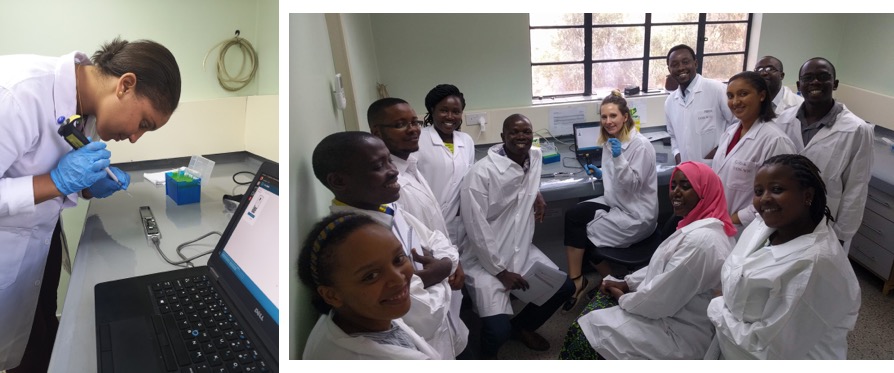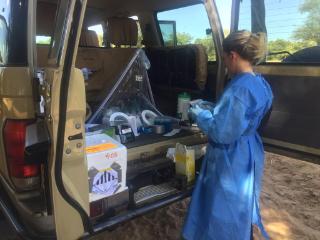Number of items: 26.
2025
Sajib, Mohammad Saiful Islam, Oravcova, Katarina  ORCID: https://orcid.org/0000-0001-5930-6803, Brunker, Kirstyn
ORCID: https://orcid.org/0000-0001-5930-6803, Brunker, Kirstyn  ORCID: https://orcid.org/0000-0001-9990-6299, Everest, Paul
ORCID: https://orcid.org/0000-0001-9990-6299, Everest, Paul  ORCID: https://orcid.org/0000-0001-6727-8048, Galarion, Ma Jowina H., Fuentes, Manuel
ORCID: https://orcid.org/0000-0001-6727-8048, Galarion, Ma Jowina H., Fuentes, Manuel  ORCID: https://orcid.org/0000-0001-9253-316X, Wilson, Catherine, Murphy, Michael E. and Forde, Taya
ORCID: https://orcid.org/0000-0001-9253-316X, Wilson, Catherine, Murphy, Michael E. and Forde, Taya  ORCID: https://orcid.org/0000-0001-9058-7826
(2025)
MultiSeq-AMR: a modular amplicon-sequencing workflow for rapid detection of bloodstream infection and antimicrobial resistance markers.
Microbial Genomics, 11(4),
001383.
(doi: 10.1099/mgen.0.001383)
ORCID: https://orcid.org/0000-0001-9058-7826
(2025)
MultiSeq-AMR: a modular amplicon-sequencing workflow for rapid detection of bloodstream infection and antimicrobial resistance markers.
Microbial Genomics, 11(4),
001383.
(doi: 10.1099/mgen.0.001383)
2024
Yuson, M. et al.
(2024)
Combining genomics and epidemiology to investigate a zoonotic outbreak of rabies in Romblon Province, Philippines.
Nature Communications, 15,
10753.
(doi: 10.1038/s41467-024-54255-5)
(PMID:39737920)
(PMCID:PMC11685615)
Durrant, R. et al.
(2024)
Examining the molecular clock hypothesis for the contemporary evolution of the rabies virus.
PLoS Pathogens, 20(11),
e1012740.
(doi: 10.1371/journal.ppat.1012740)
(PMID:39585914)
(PMCID:PMC11627394)
Jaswant, G. et al.
(2024)
Molecular characterisation of human rabies in Tanzania and Kenya: a case series report and phylogenetic investigation.
Infectious Diseases of Poverty, 13,
79.
(doi: 10.1186/s40249-024-01245-w)
(PMID:39468631)
(PMCID:PMC11514914)
Li, Yao-Tsun, Ko, Hui-Ying, Hughes, Joseph  ORCID: https://orcid.org/0000-0003-2556-2563, Liu, Ming-Tsuan, Lin, Yi-Ling, Hampson, Katie
ORCID: https://orcid.org/0000-0003-2556-2563, Liu, Ming-Tsuan, Lin, Yi-Ling, Hampson, Katie  ORCID: https://orcid.org/0000-0001-5392-6884 and Brunker, Kirstyn
ORCID: https://orcid.org/0000-0001-5392-6884 and Brunker, Kirstyn  ORCID: https://orcid.org/0000-0001-9990-6299
(2024)
From emergence to endemicity: highly pathogenic H5 avian influenza viruses in Taiwan.
Nature Communications, 15(1),
9348.
(doi: 10.1038/s41467-024-53816-y)
(PMID:39472594)
(PMCID:PMC11522503)
ORCID: https://orcid.org/0000-0001-9990-6299
(2024)
From emergence to endemicity: highly pathogenic H5 avian influenza viruses in Taiwan.
Nature Communications, 15(1),
9348.
(doi: 10.1038/s41467-024-53816-y)
(PMID:39472594)
(PMCID:PMC11522503)
Sajib, Mohammad Saiful Islam  ORCID: https://orcid.org/0000-0002-3962-9805, Brunker, Kirstyn
ORCID: https://orcid.org/0000-0002-3962-9805, Brunker, Kirstyn  ORCID: https://orcid.org/0000-0001-9990-6299, Oravcova, Katarina
ORCID: https://orcid.org/0000-0001-9990-6299, Oravcova, Katarina  ORCID: https://orcid.org/0000-0001-5930-6803, Everest, Paul
ORCID: https://orcid.org/0000-0001-5930-6803, Everest, Paul  ORCID: https://orcid.org/0000-0001-6727-8048, Murphy, Michael E. and Forde, Taya
ORCID: https://orcid.org/0000-0001-6727-8048, Murphy, Michael E. and Forde, Taya  ORCID: https://orcid.org/0000-0001-9058-7826
(2024)
Advances in host depletion and pathogen enrichment methods for rapid sequencing-based diagnosis of bloodstream infection.
Journal of Molecular Diagnostics, 26(9),
pp. 741-753.
(doi: 10.1016/j.jmoldx.2024.05.008)
(PMID:38925458)
ORCID: https://orcid.org/0000-0001-9058-7826
(2024)
Advances in host depletion and pathogen enrichment methods for rapid sequencing-based diagnosis of bloodstream infection.
Journal of Molecular Diagnostics, 26(9),
pp. 741-753.
(doi: 10.1016/j.jmoldx.2024.05.008)
(PMID:38925458)
Brunker, Kirstyn  ORCID: https://orcid.org/0000-0001-9990-6299
(2024)
Rapid pathogen surveillance: field-ready sequencing solutions.
Nature Reviews Genetics, 25(8),
532.
(doi: 10.1038/s41576-024-00734-w)
(PMID:38684856)
ORCID: https://orcid.org/0000-0001-9990-6299
(2024)
Rapid pathogen surveillance: field-ready sequencing solutions.
Nature Reviews Genetics, 25(8),
532.
(doi: 10.1038/s41576-024-00734-w)
(PMID:38684856)
2023
Bautista, Criselda, Jaswant, Gurdeep, French, Hollie, Campbell, Kathryn, Durrant, Rowan  ORCID: https://orcid.org/0000-0002-9742-2052, Gifford, Robert
ORCID: https://orcid.org/0000-0002-9742-2052, Gifford, Robert  ORCID: https://orcid.org/0000-0003-4028-9884, Kia, Grace S.N., Ogoti, Brian, Hampson, Katie
ORCID: https://orcid.org/0000-0003-4028-9884, Kia, Grace S.N., Ogoti, Brian, Hampson, Katie  ORCID: https://orcid.org/0000-0001-5392-6884 and Brunker, Kirstyn
ORCID: https://orcid.org/0000-0001-5392-6884 and Brunker, Kirstyn  ORCID: https://orcid.org/0000-0001-9990-6299
(2023)
Whole genome sequencing for rapid characterization of rabies virus using nanopore technology.
Journal of Visualized Experiments(191),
e65414.
(doi: 10.3791/65414)
(PMID:37677046)
ORCID: https://orcid.org/0000-0001-9990-6299
(2023)
Whole genome sequencing for rapid characterization of rabies virus using nanopore technology.
Journal of Visualized Experiments(191),
e65414.
(doi: 10.3791/65414)
(PMID:37677046)
Lushasi, K. et al.
(2023)
Integrating contact tracing and whole-genome sequencing to track the elimination of dog-mediated rabies: an observational and genomic study.
eLife, 12,
e85262.
(doi: 10.7554/elife.85262)
(PMID:37227428)
(PMCID:PMC10299823)
2022
Campbell, Kathryn, Gifford, Robert J.  ORCID: https://orcid.org/0000-0003-4028-9884, Singer, Joshua, Hill, Verity, O'Toole, Aine, Rambaut, Andrew, Hampson, Katie
ORCID: https://orcid.org/0000-0003-4028-9884, Singer, Joshua, Hill, Verity, O'Toole, Aine, Rambaut, Andrew, Hampson, Katie  ORCID: https://orcid.org/0000-0001-5392-6884 and Brunker, Kirstyn
ORCID: https://orcid.org/0000-0001-5392-6884 and Brunker, Kirstyn  ORCID: https://orcid.org/0000-0001-9990-6299
(2022)
Making genomic surveillance deliver: a lineage classification and nomenclature system to inform rabies elimination.
PLoS Pathogens, 18(5),
e1010023.
(doi: 10.1371/journal.ppat.1010023)
(PMID:35500026)
(PMCID:PMC9162366)
ORCID: https://orcid.org/0000-0001-9990-6299
(2022)
Making genomic surveillance deliver: a lineage classification and nomenclature system to inform rabies elimination.
PLoS Pathogens, 18(5),
e1010023.
(doi: 10.1371/journal.ppat.1010023)
(PMID:35500026)
(PMCID:PMC9162366)
Mancy, R. et al.
(2022)
Rabies shows how scale of transmission can enable acute infections to persist at low prevalence.
Science, 376(6592),
pp. 512-516.
(doi: 10.1126/science.abn0713)
(PMID:35482879)
(PMCID:PMC7613728)
Li, Y.-T. et al.
(2022)
Lineage BA.2 dominated the Omicron SARS-CoV-2 epidemic wave in the Philippines.
Virus Evolution, 8(2),
veac078.
(doi: 10.1093/ve/veac078)
(PMID:36090771)
(PMCID:PMC9452094)
2021
Li, K. K. et al.
(2021)
Genetic epidemiology of SARS-CoV-2 transmission in renal dialysis units - a high risk community-hospital interface.
Journal of Infection, 83(1),
pp. 96-103.
(doi: 10.1016/j.jinf.2021.04.020)
(PMID:33895226)
(PMCID:PMC8061788)
Rihn, S. J. et al.
(2021)
A plasmid DNA-launched SARS-CoV-2 reverse genetics system and coronavirus toolkit for COVID-19 research.
PLoS Biology, 19(2),
e3001091.
(doi: 10.1371/journal.pbio.3001091)
(PMID:33630831)
(PMCID:PMC7906417)
Da Silva Filipe, A. et al.
(2021)
Genomic epidemiology reveals multiple introductions of SARS-CoV-2 from mainland Europe into Scotland.
Nature Microbiology, 6(1),
pp. 112-122.
(doi: 10.1038/s41564-020-00838-z)
(PMID:33349681)
Faust, C. L. et al.
(2021)
Harnessing technology and portability to conduct molecular epidemiology of endemic pathogens in resource-limited settings.
Transactions of the Royal Society of Tropical Medicine and Hygiene, 115(1),
pp. 3-5.
(doi: 10.1093/trstmh/traa086)
(PMID:32945867)
(PMCID:PMC7788292)
2020
Brunker, K. et al.
(2020)
Rapid in-country sequencing of whole virus genomes to inform rabies elimination programmes.
Wellcome Open Research, 5,
3.
(doi: 10.12688/wellcomeopenres.15518.2)
(PMID:32090172)
(PMCID:PMC7001756)
2018
Brunker, Kirstyn  ORCID: https://orcid.org/0000-0001-9990-6299 and Mollentze, Nardus
ORCID: https://orcid.org/0000-0001-9990-6299 and Mollentze, Nardus  ORCID: https://orcid.org/0000-0002-2452-6416
(2018)
Rabies virus.
Trends in Microbiology, 26(10),
pp. 886-887.
(doi: 10.1016/j.tim.2018.07.001)
(PMID:30072086)
ORCID: https://orcid.org/0000-0002-2452-6416
(2018)
Rabies virus.
Trends in Microbiology, 26(10),
pp. 886-887.
(doi: 10.1016/j.tim.2018.07.001)
(PMID:30072086)
Brunker, K.  ORCID: https://orcid.org/0000-0001-9990-6299, Nadin-Davis, S. and Biek, R.
ORCID: https://orcid.org/0000-0001-9990-6299, Nadin-Davis, S. and Biek, R.  ORCID: https://orcid.org/0000-0003-3471-5357
(2018)
Genomic sequencing, evolution and molecular epidemiology of rabies virus.
Revue scientifique et technique (International Office of Epizootics), 37(2),
pp. 401-408.
(doi: 10.20506/rst.37.2.2810)
(PMID:30747139)
ORCID: https://orcid.org/0000-0003-3471-5357
(2018)
Genomic sequencing, evolution and molecular epidemiology of rabies virus.
Revue scientifique et technique (International Office of Epizootics), 37(2),
pp. 401-408.
(doi: 10.20506/rst.37.2.2810)
(PMID:30747139)
Brunker, Kirstyn  ORCID: https://orcid.org/0000-0001-9990-6299, Lemey, Philippe, Marston, Denise A., Fooks, Anthony R., Lugelo, Ahmed, Ngeleja, Chanasa, Hampson, Katie
ORCID: https://orcid.org/0000-0001-9990-6299, Lemey, Philippe, Marston, Denise A., Fooks, Anthony R., Lugelo, Ahmed, Ngeleja, Chanasa, Hampson, Katie  ORCID: https://orcid.org/0000-0001-5392-6884 and Biek, Roman
ORCID: https://orcid.org/0000-0001-5392-6884 and Biek, Roman  ORCID: https://orcid.org/0000-0003-3471-5357
(2018)
Landscape attributes governing local transmission of an endemic zoonosis: rabies virus in domestic dogs.
Molecular Ecology, 27(3),
pp. 773-788.
(doi: 10.1111/mec.14470)
(PMID:29274171)
(PMCID:PMC5900915)
ORCID: https://orcid.org/0000-0003-3471-5357
(2018)
Landscape attributes governing local transmission of an endemic zoonosis: rabies virus in domestic dogs.
Molecular Ecology, 27(3),
pp. 773-788.
(doi: 10.1111/mec.14470)
(PMID:29274171)
(PMCID:PMC5900915)
2017
Picard, Coralie, Dallot, Sylvie, Brunker, Kirstyn  ORCID: https://orcid.org/0000-0001-9990-6299, Berthier, Karine, Roumagnac, Phillipe, Soubeyrand, Samuel, Jacquot, Emmanuel and Thébaud, Gaël
(2017)
Exploiting genetic information to trace plant virus dispersal in landscapes.
Annual Review of Phytopathology, 55,
pp. 139-160.
(doi: 10.1146/annurev-phyto-080516-035616)
(PMID:28525307)
ORCID: https://orcid.org/0000-0001-9990-6299, Berthier, Karine, Roumagnac, Phillipe, Soubeyrand, Samuel, Jacquot, Emmanuel and Thébaud, Gaël
(2017)
Exploiting genetic information to trace plant virus dispersal in landscapes.
Annual Review of Phytopathology, 55,
pp. 139-160.
(doi: 10.1146/annurev-phyto-080516-035616)
(PMID:28525307)
Gilbert, Lucy, Brunker, Kirstyn  ORCID: https://orcid.org/0000-0001-9990-6299, Lande, Unni, Klingen, Ingeborg and Grøva, Lise
(2017)
Environmental risk factors for Ixodes ricinus ticks and their infestation on lambs in a changing ecosystem: Implications for tick control and the impact of woodland encroachment on tick-borne disease in livestock.
Agriculture, Ecosystems and Environment, 237,
pp. 265-273.
(doi: 10.1016/j.agee.2016.12.041)
ORCID: https://orcid.org/0000-0001-9990-6299, Lande, Unni, Klingen, Ingeborg and Grøva, Lise
(2017)
Environmental risk factors for Ixodes ricinus ticks and their infestation on lambs in a changing ecosystem: Implications for tick control and the impact of woodland encroachment on tick-borne disease in livestock.
Agriculture, Ecosystems and Environment, 237,
pp. 265-273.
(doi: 10.1016/j.agee.2016.12.041)
2015
Brunker, K. et al.
(2015)
Elucidating the phylodynamics of endemic rabies virus in eastern Africa using whole-genome sequencing.
Virus Evolution, 1(1),
pp. 1-11.
(doi: 10.1093/ve/vev011)
2012
Brunker, K., Hampson, K.  ORCID: https://orcid.org/0000-0001-5392-6884, Horton, D.L. and Biek, R.
ORCID: https://orcid.org/0000-0001-5392-6884, Horton, D.L. and Biek, R.  ORCID: https://orcid.org/0000-0003-3471-5357
(2012)
Integrating the landscape epidemiology and genetics of RNA viruses: rabies in domestic dogs as a model.
Parasitology, 139(14),
pp. 1899-1913.
(doi: 10.1017/S003118201200090X)
ORCID: https://orcid.org/0000-0003-3471-5357
(2012)
Integrating the landscape epidemiology and genetics of RNA viruses: rabies in domestic dogs as a model.
Parasitology, 139(14),
pp. 1899-1913.
(doi: 10.1017/S003118201200090X)
Decuypere, S., Vanaerschot, M., Brunker, K., Imamura, H., Muller, S., Khanal, B., Rijal, S., Dujardin, J. and Coombs, G.H.
(2012)
Molecular mechanisms of drug resistance in natural Leishmania populations vary with genetic background.
PLoS Neglected Tropical Diseases, 6(2),
e1514.
(doi: 10.1371/journal.pntd.0001514)
2010
t'Kindt, R. et al.
(2010)
Metabolomics to unveil and understand phenotypic diversity between pathogen populations.
PLoS Neglected Tropical Diseases, 4(11),
e904.
(doi: 10.1371/journal.pntd.0000904)
This list was generated on Mon Jun 30 13:42:16 2025 BST.





